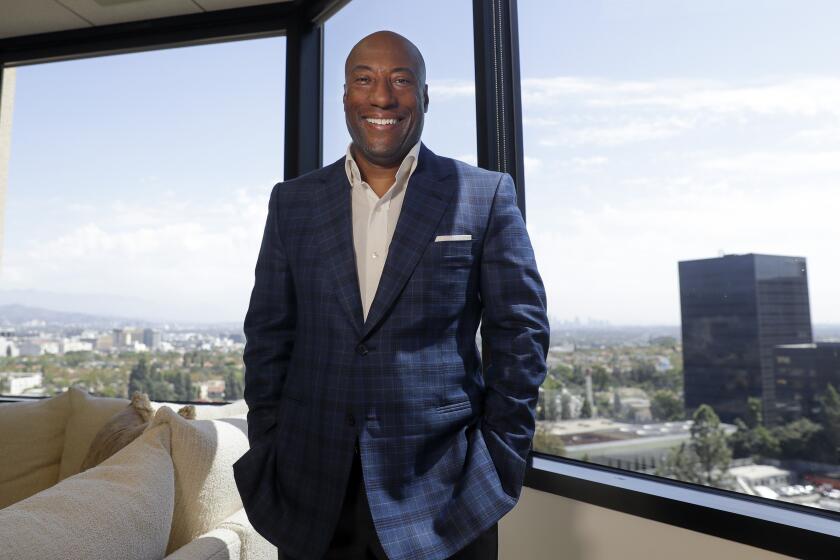Lower Profit Forecast Spurs Regency Selloff : Trading: Share prices plummet after Tustin nursing home operator announces likely earnings drop due to operating problems after merger.
- Share via
TUSTIN — Shareholders sold almost 4.7 million shares of Regency Health Services’ common stock in wild trading Wednesday as the price fell almost 40% on word that the nursing home operator’s profits will likely be far short of earlier forecasts.
Only last-minute stock buyback pledges by Regency’s chairman and its largest shareholder kept the price from plummeting lower. At one point during the day, Regency shares were trading at $7.625, down from Tuesday’s closing price of $14.125. The stock, which closed at $8.75, had traded as high as $19.375 on March 22.
The massive selloff was triggered by Regency’s announcement that its earnings for the rest of the year would fall well below the level forecast by industry analysts after Regency’s acquisition in April of fellow nursing home operator Care Enterprises of Tustin.
Richard K. Matros, Regency’s president and chief executive, blamed the decline on a loss of operating control that occurred as he and several other key officers turned their focus from daily operations to the acquisition and subsequent integration of Regency and Care personnel, systems and facilities.
“I didn’t have enough information coming to me to assess that this was an issue,” he said in an interview. “If I’d have been here or had sufficient information, I could have caught it sooner.”
More than 20% of Regency’s 20.5 million shares were traded Wednesday, about 60 times the stock’s typical daily volume.
“It’s merger indigestion,” said Linc Werden, an analyst with Prudential Securities in New York. “Top management has now admitted that the expanded operation was larger than they could comfortably handle. They were in over their depth, and operating problems developed.”
Werden said he thinks Regency can get the situation under control but cautioned that it could take time. “The people that were in charge (of integrating operations) are gone,” he said. “Though they’ve hired new people, the recovery depends on how well a relatively new operating team can perform.”
In an effort to reassure investors and prop up the tumbling share price, Smith Management Co., a Regency Health Services affiliate and the company’s largest single shareholder, with about 20% of its stock, said Wednesday it had authorized the purchase of as many as 1 million Regency shares in the open market.
Regency Chairman Cecil Mays also issued a statement before the market closed Wednesday that he had instructed his broker to purchase $100,000 worth of the company’s stock. Mays, who owned 800,000 shares when he placed the purchase order, said his losses on paper topped $4 million for the day.
Regency also said Wednesday that it will sell some facilities and has established a $10-million reserve to cover costs associated with the sales. Matros said that strategy, however, should not have affected earnings estimates because it was announced before the Care Enterprises acquisition was completed. “It was in our proxy,” issued last year, he said.
When Regency bought slightly larger Care Enterprises for $120 million worth of stock, Regency officials said they would have no problem integrating Care into their operation.
Now, however, Regency is forecasting second-quarter earnings of just 10 cents to 12 cents a share, down from 16 cents a share a year earlier and far short of the 22 cents projected by analysts.
Matros, who was Care’s president and chief executive before the acquisition, said there have been no problems associated directly with the Care operations.
“Care had to do with it only to the extent that the assimilation of the two companies caused myself and several other key people to focus on the assimilation, so we weren’t as focused as normal on other operations of the company,” he said.
The operations team charged with that task simply was not able to handle it, he said, because Regency more than doubled in size to 94 facilities from 41 with the Care purchase. The company expects revenue to top $360 million this year.
While Matros traveled the country wooing investors and grappled with the tasks of pulling two large health corporations together, the executive in charge of operations was Tim Paulsen, Regency’s senior vice president. Paulsen, who recently resigned and could not be reached for comment Wednesday, “was in over his head,” Matros said.
The problems that developed stemmed from leaving daily operations in the charge of people “who weren’t used to having responsibility for a corporation of this size,” Matros said.
He described the operating problems as loss of cost control at various facilities. With nearly 100 nursing homes to operate, an inability to keep a lid on payroll and supply spending “adds up quickly,” he said.
“Things went along pretty well for a while just out of habit, but eventually the problems showed up,” Matros said. “We run a $13-million monthly payroll, and just a few extra hours of labor a day at each facility can add $500,000 a month to that.”
A Big Decline
Regency Health Services’ stock dropped sharply Wednesday after the announcement of a decline in projected earnings. Monthly closing prices:
June, 1993: $10.63
Wednesday’s close: $8.75
Source: Dow Jones; Researched by JANICE L. JONES / Los Angeles Times
More to Read
Inside the business of entertainment
The Wide Shot brings you news, analysis and insights on everything from streaming wars to production — and what it all means for the future.
You may occasionally receive promotional content from the Los Angeles Times.










